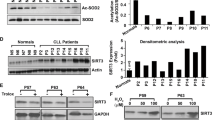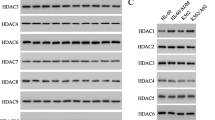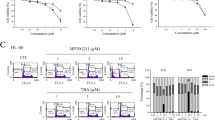Abstract
We explored if epigenetic mechanisms could be involved in the down-regulated expression of catalase gene (CAT) in the doxorubicin-resistant acute myelogenous leukemia (AML)-2/DX100 cells. Down-regulated CAT expression in AML-2/DX100 cells was completely recovered after treatment of hydrogen peroxide (H2O2) and histone deacetylase inhibitor, trichostatin A (TSA) but was increased slightly by the treatment of DNA methylation inhibitor, 5-aza-2′-deoxycytidine (5-AdC). Bisulfite-sequencing PCR revealed that a CpG island of CAT was not methylated in AML-2/DX100 cells. Chromatin immunoprecipitation assay confirmed that acetylation of histone H4 in AML-2/DX100 cells significantly decreased as compared with that in AML-2/WT cells, which was significantly increased by TSA more than 5-AdC. Meanwhile, overexpression of other up-regulated peroxidase genes appears to make compensation for decreased H2O2-scavenging activity for the down-regulated CAT expression in AML-2/DX100 cells. These results suggest that histone H4 deacetylation is responsible for the down-regulated CAT expression in AML-2/DX100 cells, which are well adapted to oxidative stress.



Similar content being viewed by others
References
Choi CH, Kim HS, Rha HS, Jeong JH, Park YH, Min YD, et al. Drug concentration-dependent expression of multidrug resistance-associated protein and P-glycoprotein in the doxorubicin-resistant acute myelogenous leukemia sublines. Mol Cells. 1999;9:314–9.
Clare DA, Duong MN, Darr D, Archibald F, Fridovich I. Effects of molecular oxygen on detection of superoxide radical with nitroblue tetrazolium and on activity stains for catalase. Anal Biochem. 1984;140:532–7.
Crescimanno M, D’Alessandro N, Armata MG, Toulmond S, Tapiero H. Modulation of the antioxidant activities in dox-sensitive and -resistant Friend leukemia cells. Effect of doxorubicin. Anticancer Res. 1991;11:901–3.
Egger G, Aparicio AM, Escobar SG, Jones PA. Inhibition of histone deacetylation does not block resilencing of p16 after 5-aza-2′-deoxycytidine treatment. Cancer Res. 2007;67:346–53.
Felsenfeld G, Groudine M. Controlling the double helix. Nature. 2003;421:448–53.
Fischle W, Wang Y, Allis CD. Histone and chromatin cross-talk. Curr Opin Cell Biol. 2003;15:172–83.
Fuks F, Hurd PJ, Wolf D, Nan X, Bird AP, Kouzarides T. The methyl-CpG-binding protein MeCP2 links DNA methylation to histone methylation. J Biol Chem. 2003;278:4035–40.
Geiman TM, Robertson KD. Chromatin remodeling, histone modifications, and DNA methylation-how does it all fit together? J Cell Biochem. 2002;87:117–25.
Hampsey M. Molecular genetics of the RNA polymerase II general transcriptional machinery. Microbiol Mol Biol Rev. 1998;62:465–503.
Harris RN, Doroshow JH. Effect of doxorubicin-enhanced hydrogen peroxide and hydroxyl radical formation on calcium sequestration by cardiac sarcoplasmic reticulum. Biochem Biophys Res Commun. 1985;130:739–45.
Hoffschir F, Vuillaume M, Sabatier L, Ricoul M, Daya-Grosjean L, Estrade S, et al. Decrease in catalase activity and loss of the 11p chromosome arm in the course of SV40 transformation of human fibroblasts. Carcinogenesis. 1993;14:1569–72.
Ikeda M, Kodama H, Fukuda J, Shimizu Y, Murata M, Kumagai J, et al. Role of radical oxygen species in rat testicular germ cell apoptosis induced by heat stress. Biol Reprod. 1999;61:393–9.
Ito K, Hanazawa T, Tomita K, Barnes PJ, Adcock IM. Oxidative stress reduces histone deacetylase 2 activity and enhances IL-8 gene expression: role of tyrosine nitration. Biochem Biophys Res Commun. 2004;315:240–5.
Jones PL, Veenstra GJ, Wade PA, Vermaak D, Kass SU, Landsberger N, et al. Methylated DNA and MeCP2 recruit histone deacetylase to repress transcription. Nat Genet. 1998;19:187–91.
Kang YJ, Chen Y, Epstein PN. Suppression of doxorubicin cardiotoxicity by overexpression of catalase in the heart of transgenic mice. J Biol Chem. 1996;271:12610–6.
Kang J, Chen J, Shi Y, Jia J, Zhang Y. Curcumin-induced histone hypoacetylation: the role of reactive oxygen species. Biochem Pharmacol. 2005;69:1205–13.
Kim HS, Lee TB, Choi CH. Down-regulation of catalase gene expression in the doxorubicin-resistant AML subline AML-2/DX100. Biochem Biophys Res Commun. 2001a;281:109–14.
Kim HS, Min YD, Choi CH. Double-edged sword of chemosensitizer: increase of multidrug resistance protein (MRP) in leukemic cells by an MRP inhibitor probenecid. Biochem Biophys Res Commun. 2001b;283:64–71.
Laird PW. Cancer epigenetics. Hum Mol Genet. 2005;14(Spec No 1):R65–76.
Li LC, Dahiya R. MethPrimer: designing primers for methylation PCRs. Bioinformatics (Oxford). 2002;18:1427–31.
Li ZX, Ma X, Wang ZH. A differentially methylated region of the DAZ1 gene in spermatic and somatic cells. Asian J Androl. 2006;8:61–7.
Lin C, Kang J, Zheng R. Vitamin K3 triggers human leukemia cell death through hydrogen peroxide generation and histone hyperacetylation. Pharmazie. 2005;60:765–71.
Lu J, Papp LV, Fang J, Rodriguez-Nieto S, Zhivotovsky B, Holmgren A. Inhibition of mammalian thioredoxin reductase by some flavonoids: implications for myricetin and quercetin anticancer activity. Cancer Res. 2006;66:4410–8.
Matecic M, Stuart S, Holmes SG. SIR2-induced inviability is suppressed by histone H4 overexpression. Genetics. 2002;162:973–6.
Nakagawa CW, Yamada K, Mutoh N. Two distinct upstream regions are involved in expression of the catalase gene in Schizosaccharomyces pombe in response to oxidative stress. J Biochem (Tokyo). 1998;123:1048–54.
Nakagawa CW, Yamada K, Mutoh N. Identification of the catalase gene promoter region involved in superinduction in Schizosaccharomyces pombe caused by cycloheximide and hydrogen peroxide. FEMS Microbiol Lett. 1999;173:373–8.
Nonn L, Berggren M, Powis G. Increased expression of mitochondrial peroxiredoxin-3 (thioredoxin peroxidase-2) protects cancer cells against hypoxia and drug-induced hydrogen peroxide-dependent apoptosis. Mol Cancer Res. 2003;1:682–9.
Oh YK, Lee TB, Choi CH. Anti-oxidant adaptation in the AML cells supersensitive to hydrogen peroxide. Biochem Biophys Res Commun. 2004;319:41–5.
Prahalathan C, Selvakumar E, Varalakshmi P. Remedial effect of dl-alpha-lipoic acid against adriamycin induced testicular lipid peroxidation. Mol Cell Biochem. 2004;267:209–14.
Ramu A, Cohen L, Glaubiger D. Oxygen radical detoxification enzymes in doxorubicin-sensitive and -resistant P388 murine leukemia cells. Cancer Res. 1984;44:1976–80.
Santos-Rosa H, Schneider R, Bannister AJ, Sherriff J, Bernstein BE, Emre NC, et al. Active genes are tri-methylated at K4 of histone H3. Nature. 2002;419:407–11.
Sato K, Ito K, Kohara H, Yamaguchi Y, Adachi K, Endo H. Negative regulation of catalase gene expression in hepatoma cells. Mol Cell Biol. 1992;12:2525–33.
Sun Y, Colburn NH, Oberley LW. Depression of catalase gene expression after immortalization and transformation of mouse liver cells. Carcinogenesis. 1993;14:1505–10.
Thaete C, Brett D, Monaghan P, Whitehouse S, Rennie G, Rayner E, et al. Functional domains of the SYT and SYT-SSX synovial sarcoma translocation proteins and co-localization with the SNF protein BRM in the nucleus. Hum Mol Genet. 1999;8:585–91.
Towbin H, Staehelin T, Gordon J. Electrophoretic transfer of proteins from polyacrylamide gels to nitrocellulose sheets: procedure and some applications. Proc Natl Acad Sci USA. 1979;76:4350–4.
Wada H, Kagoshima M, Ito K, Barnes PJ, Adcock IM. 5-Azacytidine suppresses RNA polymerase II recruitment to the SLPI gene. Biochem Biophys Res Commun. 2005;331:93–9.
Yamaguchi Y, Sato K, Endo H. Depression of catalase gene expression in the liver of tumor bearing nude mice. Biochem Biophys Res Commun. 1992;189:1084–9.
Yoshida M, Kijima M, Akita M, Beppu T. Potent and specific inhibition of mammalian histone deacetylase both in vivo and in vitro by trichostatin A. J Biol Chem. 1990;265:17174–9.
Acknowledgements
This work was supported by National Research Foundation of Korea grant funded by the Ministry of Education, Science and Technology (MEST) through the Research Center for Resistant Cells (R13-2003-009). We thank Mrs. H. S. Kim and Y. K. Seo for expert technical assistance.
Author information
Authors and Affiliations
Corresponding author
Rights and permissions
About this article
Cite this article
Lee, TB., Moon, YS. & Choi, CH. Histone H4 deacetylation down-regulates catalase gene expression in doxorubicin-resistant AML subline. Cell Biol Toxicol 28, 11–18 (2012). https://doi.org/10.1007/s10565-011-9201-y
Received:
Accepted:
Published:
Issue Date:
DOI: https://doi.org/10.1007/s10565-011-9201-y




